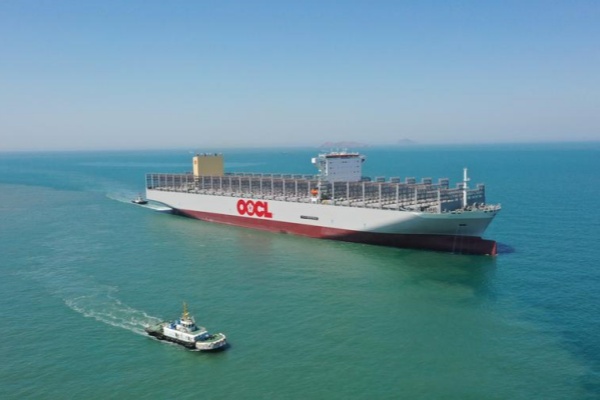
- Home
- Media Center
-
Events
- Wuzhen Summit
- Regional Forums
- Practice Cases of Jointly Building a Community with a Shared Future in Cyberspace
- World Internet Conference Awards for Pioneering Science and Technology
- The Light of Internet Expo
- Straight to Wuzhen Competition
- Global Youth Leadership Program
- WIC Distinguished Contribution Award
- Membership
- Research & Cooperation
- Digital Academy
-
Reports
- Collection of cases on Jointly Building a Community with a Shared Future in Cyberspace
- Collection of Shortlisted Achievements of World Internet Conference Awards for Pioneering Science and Technology
- Reports on Artificial Intelligence
- Reports on Cross — Border Ecommerce
- Reports on Data
- Outcomes of Think Tank Cooperation Program
- Series on Sovereignty in Cyberspace Theory and Practice
- Other Achievements
- About WIC
- 中文 | EN

China's new FuXi AI weather model eyes maritime transportation, new energy sector

This photo taken on July 12, 2023 shows the ultra-large container ship named "OOCL Felixstowe" in a trial trip in Dalian, northeast China's Liaoning Province. [Photo/Dalian COSCO KHI Ship Engineering Co., Ltd.]
SHANGHAI -- Chinese scientists have upgraded an AI-powered large model, forming part of the FuXi series, for climate and weather forecasting, featuring improved accuracy. They are exploring the model's application in maritime and aviation transportation, and the new energy sector.
The Shanghai Academy of Artificial Intelligence for Science (SAIS) and Fudan University unveiled the upgraded model, known as FuXi 2.0, on Monday. It is the first global large weather model for weather routing, according to a press release of the university.
"FuXi-Subseasonal," the first model of the FuXi series, was unveiled during the 28th session of the Conference of the Parties to the United Nations Framework Convention on Climate Change (COP28) in Dubai, United Arab Emirates, in December 2023. It represented a significant advancement in AI climate modeling, as it extended the forecasting range to 42 days.
Compared to "FuXi-Subseasonal," FuXi 2.0 has made progress in terms of mid-term weather forecasting models and sub-seasonal models, targeting industries such as new energy, and aviation and maritime transportation, said Li Hao, who leads the SAIS earth science research team.
Through cooperation with China COSCO Shipping Cooperation Limited, Li said FuXi 2.0 is capable of delivering hourly high-resolution forecasts for a period of 15 days. The new model incorporates elements such as wind, waves, swells, and sea surface temperature to enhance the accuracy of predictions for wind, waves, currents, and visibility worldwide.
Li underscored FuXi 2.0's significant progress in prediction accuracy for extreme weather phenomena like typhoons, heavy precipitation, and other hazardous conditions.
FuXi 2.0 is expected to help reduce long-term dependence on foreign service providers for offshore weather routing, he said.
In the new energy sector, FuXi 2.0 offers more accurate forecasts concerning wind speed, solar irradiance and power generation to optimize the efficiency of wind and solar power generation, balancing of the grid load, and reduction of wind and solar power curtailment.
"It can be seen as an intelligent navigation system for wind and solar farms," said Li.
Feng Shuhai, an expert with the Electric Power Automation Department of China Electric Power Research Institute, praised FuXi 2.0 for its accurate forecasts of wind speed and solar irradiance.
It can improve the efficiency of power scheduling and management. "We look forward to FuXi's growth and the collective efforts to reduce operating costs in the power industry," said Feng.
Meanwhile, FuXi 2.0 has pioneered the development of meteorological parameters such as low cloud cover and total cloud cover, which are of great concern to the aviation industry.
Therefore, it is able to help predict various weather phenomena that may be encountered during flights, such as icing, turbulence, and uneven light conditions, improving flight experiences and reducing costs, said Li.
Looking at the future, Li said the research team plans to develop a large model of the Earth system to provide forecasts concerning the atmosphere, ocean, land surface and cryosphere, and explore forecasts in the categories of atmospheric pollution and climate risks.

The World Internet Conference (WIC) was established as an international organization on July 12, 2022, headquartered in Beijing, China. It was jointly initiated by Global System for Mobile Communication Association (GSMA), National Computer Network Emergency Response Technical Team/Coordination Center of China (CNCERT), China Internet Network Information Center (CNNIC), Alibaba Group, Tencent, and Zhijiang Lab.





